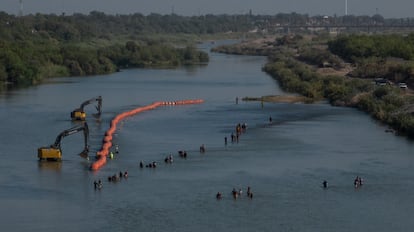Texas ordered to remove ‘floating wall’ of buoys on Rio Grande
The federal court decision delivered a second judicial setback in a week to Gov. Greg Abbott’s measures to reduce illegal immigration


In a fresh judicial setback to Texas a federal judge has ordered the state administration of Greg Abbott to remove the floating wall of buoys that it had placed on the Rio Bravo, the natural border between the United States and Mexico. Abbott’s maneuver — one of his main strategies to reduce the flow of immigrants in the area — had been criticized by the Mexican government and by Joe Biden’s administration, which took the Texan authorities to court to force them to remove the barrier. Diplomats and human rights organizations have also expressed their concerns over the barrier. The ruling, announced Friday, is the second court defeat for Texas in the space of a week. Another ruling Wednesday gave federal Border Patrol agents the green light to cut the barbed wire installed by state police.
The decision on the floating wall was made by the Fifth Circuit Court of Appeals in New Orleans, a court that tends to uphold conservative cases. The order requires local authorities to bring the 300 meters of buoys that have been deployed over the river to the U.S. side. The ruling upheld a lower court decision by Judge David Ezra in September, who reached the same conclusion. The Texas government, one of the most radical on immigration policy, had appealed the court’s decision, believing that Ezra had erred.
Texas had argued that the parts of the river where the floating barrier had been deployed were not subject to federal law, but local law. This was disputed by Washington, which claimed that the buoys impeded proper patrolling and hindered operations on the river. Judge Dana Douglas agreed with the federal government. She also stated in her ruling that the wall has created a “potential risk to human lives.” In August, the bodies of two drowned migrants were found between the buoys, located between Eagle Pass, Texas and Piedras Negras, Coahuila. The Mexican Foreign Ministry stated at the time that Abbott’s strategy not only violated Mexican sovereignty but also impacted “the safety, integrity and human rights” of migrants.
Friday’s decision does not signal an end to the controversy between Washington and Austin. Governor Abbott used social networks to announce that his government will extend the litigation, raising the lawsuit to a higher instance. “We’ll go to SCOTUS if needed to protect Texas from Biden’s open borders,” he said. Abbott is a supporter of the draconian measures that Donald Trump imposed on the border during his presidency. A few days ago, the governor endorsed the former president for the 2024 presidential campaign. He did so at an event in Edinburg, one of the areas that has been at the forefront of the sharp increase in immigration in recent months. Some 400,000 people have tried to cross there over the last year, according to official figures.
Friday’s ruling laid bare the tensions that Biden’s immigration policy has provoked. In a private vote, Judge Don Willet, who was nominated to the Fifth Circuit by Trump, stated that the decision does not iron out the differences that the measure has caused with the government of Mexican President Andrés Manuel López Obrador. “If the district court had given credence to the arguments of the United States, then it would have ordered the barrier to be removed, not moved,” Willet said.
On Wednesday Alia Moses, a district judge, ruled that Border Patrol agents can cut the 30 miles of barbed wire that Texas police erected near Eagle Pass to keep immigrants out. Moses’ ruling, a magistrate elected to the post by George W. Bush, was more Solomonic because she considered that it can be an effective measure to prevent the entry of people in other parts of the 1,180 miles of border that Texas shares with Mexico.
Sign up for our weekly newsletter to get more English-language news coverage from EL PAÍS USA Edition
Tu suscripción se está usando en otro dispositivo
¿Quieres añadir otro usuario a tu suscripción?
Si continúas leyendo en este dispositivo, no se podrá leer en el otro.
FlechaTu suscripción se está usando en otro dispositivo y solo puedes acceder a EL PAÍS desde un dispositivo a la vez.
Si quieres compartir tu cuenta, cambia tu suscripción a la modalidad Premium, así podrás añadir otro usuario. Cada uno accederá con su propia cuenta de email, lo que os permitirá personalizar vuestra experiencia en EL PAÍS.
¿Tienes una suscripción de empresa? Accede aquí para contratar más cuentas.
En el caso de no saber quién está usando tu cuenta, te recomendamos cambiar tu contraseña aquí.
Si decides continuar compartiendo tu cuenta, este mensaje se mostrará en tu dispositivo y en el de la otra persona que está usando tu cuenta de forma indefinida, afectando a tu experiencia de lectura. Puedes consultar aquí los términos y condiciones de la suscripción digital.
More information
Archived In
Últimas noticias
David Bowie, the galactic thinker who encouraged us to break new ground
John Berger and the loss of rural culture
From police officer to bloodthirsty kidnapper: Terror in Mexico during the years of ‘The Ear Chopper’
Alain Aspect, Nobel laureate in physics: ‘Einstein was so smart that he would have had to recognize quantum entanglement’
Most viewed
- David King, chemist: ‘There are scientists studying how to cool the planet; nobody should stop these experiments from happening’
- Reinhard Genzel, Nobel laureate in physics: ‘One-minute videos will never give you the truth’
- Oona Chaplin: ‘I told James Cameron that I was living in a treehouse and starting a permaculture project with a friend’
- Mexico completes its trade shift with the entry into force of tariffs on China and countries without trade agreements
- Sinaloa Cartel war is taking its toll on Los Chapitos










































